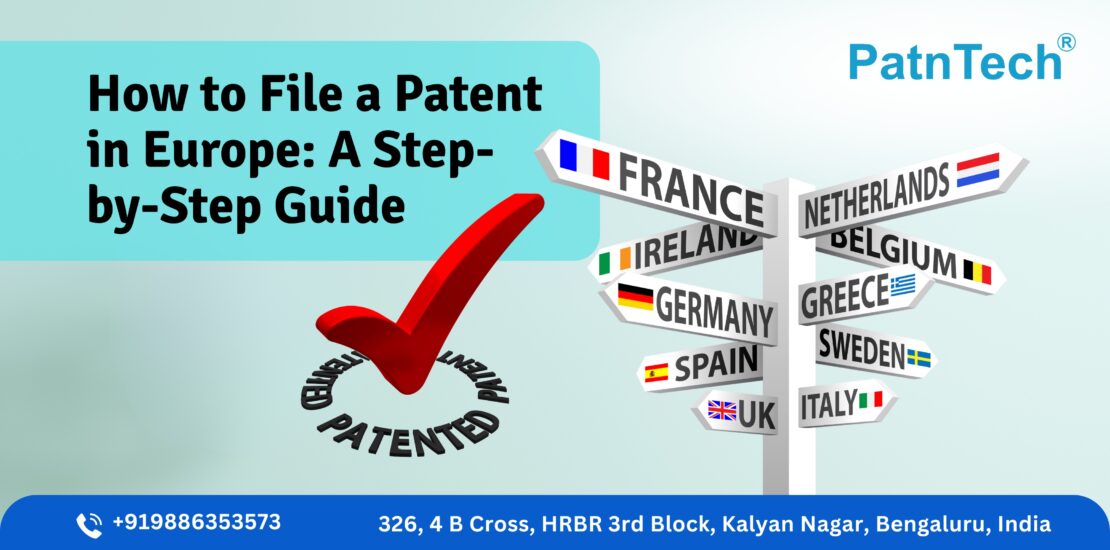How to File a Patent in Europe: A Step-by-Step Guide
- April 24, 2025
- Posted by: Patntech
- Categories: Blog, European Patents

Secure exclusive rights to your invention by filing a patent in Europe. This process protects your innovation across multiple countries, boosting its value and market potential. Follow this step-by-step guide to navigate the European patent system with confidence.
Step 1: Confirm Your Invention’s Eligibility
Ensure your invention meets the European Patent Office (EPO) criteria:
- Novelty: Your invention must be new and not publicly disclosed anywhere.
- Significant Improvement: It should offer a non-obvious advance over existing technology.
- Industrial Use: The invention must have a practical application, such as in manufacturing or technology.
Conduct a prior art search using Espacenet, the EPO’s free patent database, to check for similar inventions. For thorough results, consider hiring a professional patent search service.
Step 2: Select the Best Filing Route
Choose the patent filing option that suits your needs:
- National Patent Offices: File directly with individual countries (e.g., Germany, France) for protection in specific markets.
- European Patent Office (EPO): Submit one application to protect your invention in up to 39 member states, including Germany, France, and the UK.
- Patent Cooperation Treaty (PCT): File an international application and enter the European phase within 31 months for broader coverage.
For protection in multiple European countries, the EPO route is often the most cost-effective and efficient.
Step 3: Prepare and Submit Your Application
Craft a complete patent application, including:
- Technical Description: Explain how your invention works in detail.
- Patent Claims: Define the scope and unique aspects of your invention.
- Drawings (if applicable): Include visuals, such as diagrams of a new device.
- Abstract: Provide a brief summary of your invention.
File your application in English, French, or German via the EPO’s online portal or a national patent office. Expect filing fees of EUR 5000 for filing, search and examination, plus attorney fees of EUR2,000-6,000, depending on complexity.
Step 4: Undergo Examination and Publication
The EPO reviews your application in two stages:
- Formal Examination: Verifies that all documents are complete and correctly formatted.
- Substantive Examination: Assesses novelty, significant improvement, and industrial use.
After the formal examination, the EPO publishes your application 18 months from the filing date, making it publicly visible. The entire examination process typically takes 2-4 years.
Step 5: Secure Patent Grant and Validation
If approved, the EPO grants your patent. Validate it in your chosen countries by paying national fees and, in some cases, submitting translations of the patent into local languages (e.g., Italian or Spanish). The London Agreement reduces translation requirements in countries like Germany and France, lowering costs. Validation costs vary but typically range from €500-€5,000 per country.
Step 6: Maintain Your Patent
Keep your patent active by paying annual renewal fees. Pay fees to the EPO for the first 10 years, then to national patent offices after the grant. A European patent lasts up to 20 years if fees are paid on time. Renewal fees range from EUR650-1800 per country annually.
Also Read: The Cost of Obtaining a Patent in India
Why File a Patent in Europe?
Filing a European patent offers Indian inventors:
- Innovation Protection: Prevent others from using or copying your invention.
- Market Expansion: Access a 500-million-consumer market across multiple countries.
- Business Growth: License your patent to generate revenue or attract investors.
For example, a new software tool or medical device patented in Europe can open doors to global partnerships.
Key Tips for Success
- File Early: Secure your filing date to establish priority over competitors.
- Hire a Patent Attorney: Engage an EPO-registered professional to draft claims and handle examinations.
- Plan for Costs: Budget for filing, examination, validation, and renewal fees.
- Consider the PCT Route: Use a PCT application for flexibility if targeting Europe and other regions.
- Stay Updated: Monitor changes in European patent laws to ensure compliance.
Conclusion
Filing a patent in Europe protects your invention and strengthens your position in a major global market. By following these steps, conducting thorough research, and seeking expert guidance, Indian inventors can successfully secure a European patent. Start your patent journey today to gain a competitive edge.
